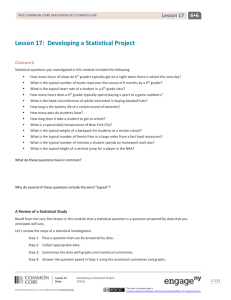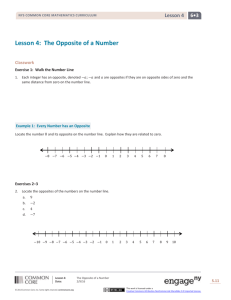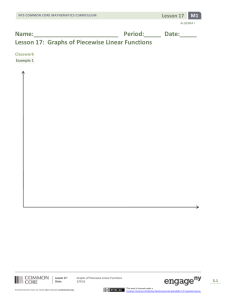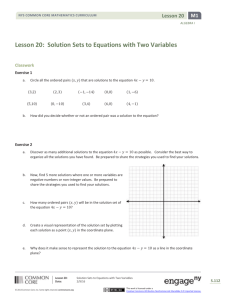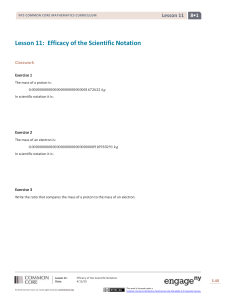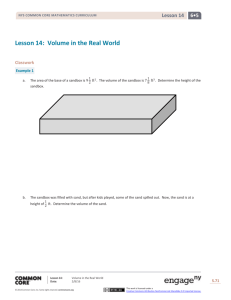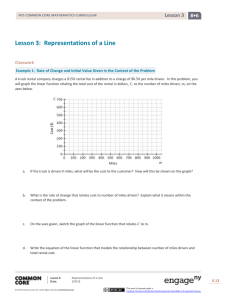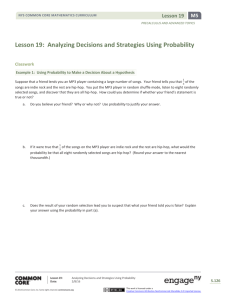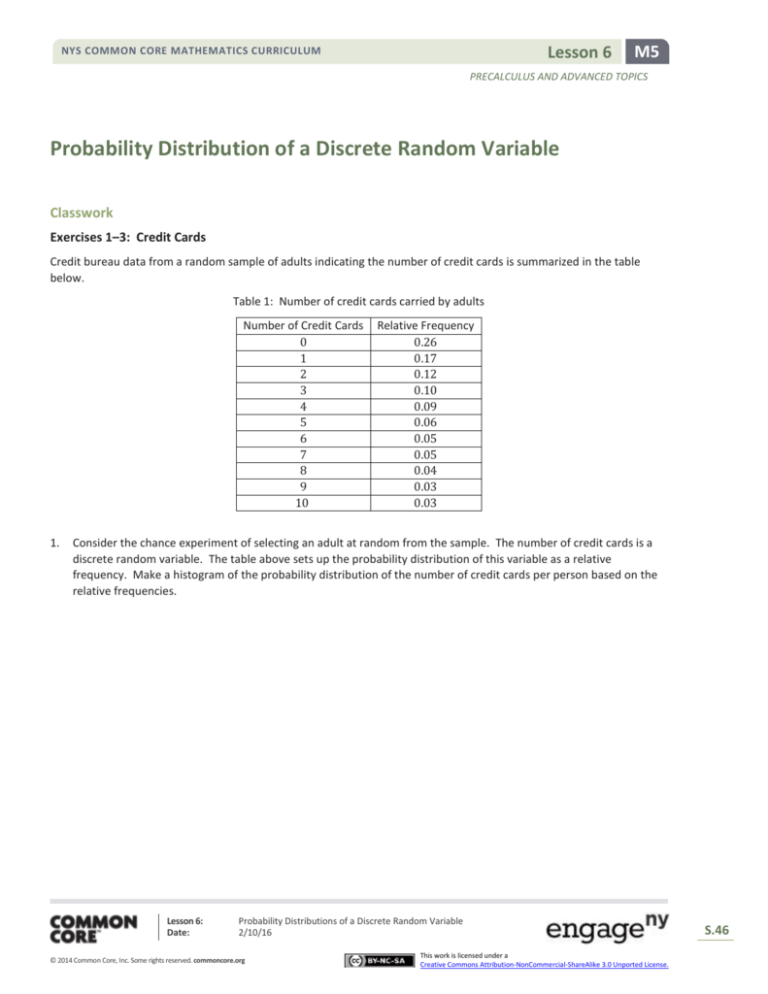
Lesson 6
NYS COMMON CORE MATHEMATICS CURRICULUM
M5
PRECALCULUS AND ADVANCED TOPICS
Probability Distribution of a Discrete Random Variable
Classwork
Exercises 1–3: Credit Cards
Credit bureau data from a random sample of adults indicating the number of credit cards is summarized in the table
below.
Table 1: Number of credit cards carried by adults
Number of Credit Cards
0
1
2
3
4
5
6
7
8
9
10
1.
Relative Frequency
0.26
0.17
0.12
0.10
0.09
0.06
0.05
0.05
0.04
0.03
0.03
Consider the chance experiment of selecting an adult at random from the sample. The number of credit cards is a
discrete random variable. The table above sets up the probability distribution of this variable as a relative
frequency. Make a histogram of the probability distribution of the number of credit cards per person based on the
relative frequencies.
Lesson 6:
Date:
Probability Distributions of a Discrete Random Variable
2/10/16
© 2014 Common Core, Inc. Some rights reserved. commoncore.org
This work is licensed under a
Creative Commons Attribution-NonCommercial-ShareAlike 3.0 Unported License.
S.46
Lesson 6
NYS COMMON CORE MATHEMATICS CURRICULUM
M5
PRECALCULUS AND ADVANCED TOPICS
2.
3.
Answer the following questions based on the probability distribution.
a.
Describe the distribution.
b.
Is a randomly selected adult more likely to have 0 credit cards or 7 or more credit cards?
c.
Find the area of the bar representing 0 credit cards.
d.
What is the area of all of the bars in the histogram? Explain your reasoning.
Suppose you asked each person in a random sample of 500 people how many credit cards he or she has. Would the
following surprise you? Explain why or why not in each case.
a.
Everyone in the sample owned at least one credit card.
b.
65 people had 2 credit cards.
c.
300 people had at least 3 credit cards.
Lesson 6:
Date:
Probability Distributions of a Discrete Random Variable
2/10/16
© 2014 Common Core, Inc. Some rights reserved. commoncore.org
This work is licensed under a
Creative Commons Attribution-NonCommercial-ShareAlike 3.0 Unported License.
S.47
Lesson 6
NYS COMMON CORE MATHEMATICS CURRICULUM
M5
PRECALCULUS AND ADVANCED TOPICS
d.
150 people had more than 7 credit cards.
Exercises 4–7: Male and Female Pups
4.
The probability that certain animals will give birth to a male or a female is generally estimated to be equal, or
approximately 0.50. This estimate, however, is not always the case. Data are used to estimate the probability that
the offspring of certain animals will be a male or a female. Scientists are particularly interested about the
probability that an offspring will be a male or a female for animals that are at a high risk of survival. In a certain
species of seals, two females are born for every male. The typical litter size for this species of seals is six pups.
a.
What are some statistical questions you might want to consider about these seals?
b.
What is the probability that a pup will be a female? A male? Explain your answer.
c.
Assuming that births are independent, which of the following can be used to find the probability that the first
two pups born in a litter will be male? Explain your reasoning.
i.
ii.
iii.
iv.
1
3
+
1
3
1
1
3
3
1
2
( )( )
( )( )
3
3
1
2( )
3
Lesson 6:
Date:
Probability Distributions of a Discrete Random Variable
2/10/16
© 2014 Common Core, Inc. Some rights reserved. commoncore.org
This work is licensed under a
Creative Commons Attribution-NonCommercial-ShareAlike 3.0 Unported License.
S.48
Lesson 6
NYS COMMON CORE MATHEMATICS CURRICULUM
M5
PRECALCULUS AND ADVANCED TOPICS
5.
The probability distribution for the number of males in a litter of six pups is given below.
Table 2: Probability distribution of number of male pups per litter*
Number of
male pups
0
1
2
3
4
5
6
*
Probability
0.088
0.243
0.33
0.22
0.075
0.018
0.001
The sum of the probabilities in the table is not equal to 1 due to rounding.
Use the probability distribution to answer the following questions.
6.
a.
How many male pups will typically be in a litter?
b.
Is a litter more likely to have six male pups or no male pups?
Based on the probability distribution of the number of male pups in a litter of six given above, indicate whether you
would be surprised in each of the situations. Explain why or why not.
a.
In every one of a female’s five litters of pups, there were fewer males than females.
b.
A female had only one male in two litters of pups.
Lesson 6:
Date:
Probability Distributions of a Discrete Random Variable
2/10/16
© 2014 Common Core, Inc. Some rights reserved. commoncore.org
This work is licensed under a
Creative Commons Attribution-NonCommercial-ShareAlike 3.0 Unported License.
S.49
Lesson 6
NYS COMMON CORE MATHEMATICS CURRICULUM
M5
PRECALCULUS AND ADVANCED TOPICS
7.
c.
A female had two litters of pups that were all males.
d.
In a certain region of the world, scientists found that in 100 litters born to different females, 25 of them had
four male pups.
How would the probability distribution change if the focus was the number of females rather than the number of
males?
Lesson 6:
Date:
Probability Distributions of a Discrete Random Variable
2/10/16
© 2014 Common Core, Inc. Some rights reserved. commoncore.org
This work is licensed under a
Creative Commons Attribution-NonCommercial-ShareAlike 3.0 Unported License.
S.50
Lesson 6
NYS COMMON CORE MATHEMATICS CURRICULUM
M5
PRECALCULUS AND ADVANCED TOPICS
Lesson Summary
The probability distribution of a discrete random variable in table or graphical form describes the long-run behavior
of a random variable.
Problem Set
1.
Which of the following could be graphs of a probability distribution? Explain your reasoning in each case.
b.
.6
.6
.5
.5
.4
.4
Probability
Probability
a.
.3
.2
.2
.1
.1
0
0
1
2
3
4
5
6
Variable
7
8
9
0
10
c.
0
1
2
3
4
5
6
Variable
7
8
9
10
0
1
2
3
4
5
6
Variable
7
8
9
10
d.
.6
.6
.5
.5
.4
.4
Probability
Probability
.3
.3
.3
.2
.2
.1
.1
0
0
1
2
3
4
5
6
Variable
Lesson 6:
Date:
7
8
9
10
0
Probability Distributions of a Discrete Random Variable
2/10/16
© 2014 Common Core, Inc. Some rights reserved. commoncore.org
This work is licensed under a
Creative Commons Attribution-NonCommercial-ShareAlike 3.0 Unported License.
S.51
Lesson 6
NYS COMMON CORE MATHEMATICS CURRICULUM
M5
PRECALCULUS AND ADVANCED TOPICS
2.
Consider randomly selecting a student from New York City schools and recording the value of the random variable
number of languages in which the student can carry on a conversation. A random sample of 1,000 students
produced the following data.
Table 3: Number of languages spoken by random sample of students in New York City
Number of languages
Number of students
3.
1
542
2
280
3
71
4
40
5
34
6
28
7
5
a.
Create a probability distribution of the relative frequencies of the number of languages students can use to
carry on a conversation.
b.
If you took a random sample of 650 students, would it be likely that 350 of them only spoke one language?
Why or why not?
c.
If you took a random sample of 650 students, would you be surprised if 100 of them spoke exactly 3
languages? Why or why not?
d.
Would you be surprised if 448 students spoke at least two languages? Why or why not?
Suppose someone created a special six-sided die. The probability distribution for the number of spots on the top
face when the die is rolled is given in the table.
Table 5: Probability distribution of the top face when rolling a die
Face
Probability
1
2
3
4
5
6
1−𝑥
6
1−𝑥
6
1−𝑥
6
1+𝑥
6
1+𝑥
6
1+𝑥
6
a.
If 𝑥 is an integer, what does 𝑥 have to be in order for this to be a valid probability distribution?
b.
Find the probability of getting a 4.
c.
What is the probability of rolling an even number?
Lesson 6:
Date:
Probability Distributions of a Discrete Random Variable
2/10/16
© 2014 Common Core, Inc. Some rights reserved. commoncore.org
This work is licensed under a
Creative Commons Attribution-NonCommercial-ShareAlike 3.0 Unported License.
S.52
Lesson 6
NYS COMMON CORE MATHEMATICS CURRICULUM
M5
PRECALCULUS AND ADVANCED TOPICS
4.
The graph shows the relative frequencies of the number of pets for households in a particular community.
0.30
Probability
0.25
0.20
0.15
0.10
0.05
0.00
0
1
2
3
4
Number of Pets
5
6
7
a.
If a household in the community is selected at random, what is the probability that a household would have at
least 1 pet?
b.
Do you think it would be likely to have 25 households with 4 pets in a random sample of 225 households?
Why or why not?
c.
Suppose the results of a survey of 350 households in a section of a city found 175 of them did not have any
pets. What comments might you make?
Lesson 6:
Date:
Probability Distributions of a Discrete Random Variable
2/10/16
© 2014 Common Core, Inc. Some rights reserved. commoncore.org
This work is licensed under a
Creative Commons Attribution-NonCommercial-ShareAlike 3.0 Unported License.
S.53

